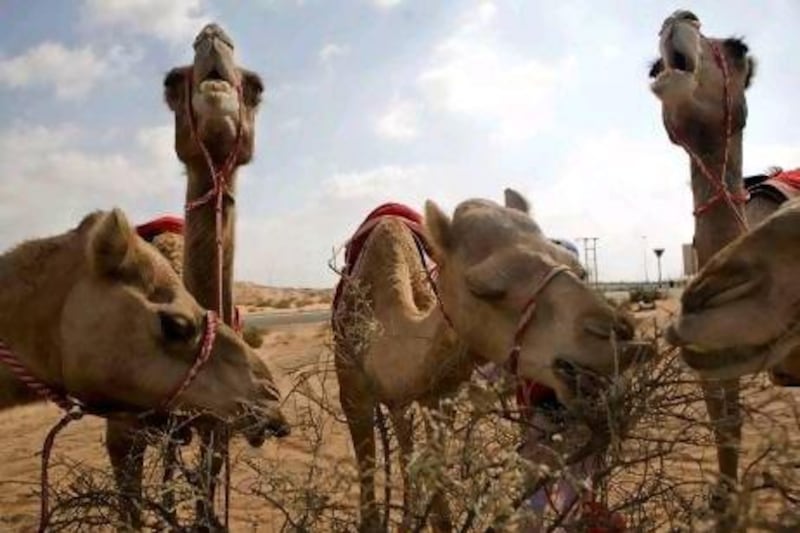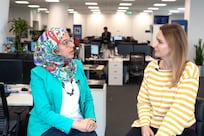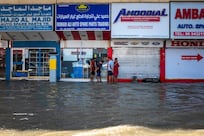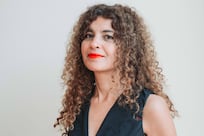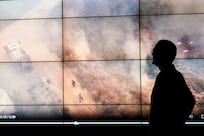Their ability to withstand inhospitable climes has given them an almost mythical status, hence the camel is often cited as the ultimate symbol of Arabic culture. Although few in this region actually rely on camels for their survival these days, they remain highly revered beasts that, as well as having practical purposes in racing and for their nutrient-laden milk, are cherished as a tangible link to a largely departed nomadic way of life.
And yet, it's a general truth that few of us are fully aware of how these creatures are able to survive and prosper in harsh desert conditions.
Dr Lulu Skidmore has been the scientific director of the Camel Reproduction Centre (CRC) in Dubai since 1994 and boasts a PhD from Cambridge University in the study of camels. As one of the world's foremost authorities on the subject, few surpass her wealth of knowledge on the humped beasts.
Thus, Skidmore was recently invited by the Emirates Natural History Group Abu Dhabi to impart some of her expertise to members of the organisation.
Skidmore is no stranger to the pages of The National, after the CRC's cloning, embryo-freezing and artificial insemination projects were the subject of features last year.
However, in her speech to the mostly middle-aged, expat audience of the ENHG at Abu Dhabi Women's College, this time she focused on the evolutionary progressions that have enabled the camel to make its home in the sandy realms of the globe.
As she explains, all camelids - the biological family that includes the one-humped dromedary, the two-humped Bactrian, as well as South American camelids such as the llama and alpaca - have a common evolutionary ancestor that originated from what is now North America around 45 million years ago.
"Amazingly enough, they were all related once," says Skidmore. "They might not look very similar, but they all started off as one species. Some of these creatures migrated south into South America while some crossed the Bering Straight into China and Russia; some went further on across the continent into the Arabian Peninsula and into Africa and these evolved into the dromedary camels we know of today."
Despite the fact that one-third of the world's land surface is arid - which, speaking scientifically, means that the annual evaporation of water exceeds the amount of rainfall - camels are among just a few mammals that can survive in such surroundings.
"This is because they won't over-poach an area. If you think of cattle grazing around a waterhole, they tend to eat all the grass, so have to travel further and further away from the water," she reveals.
"Camels are not going to do this, because they have these long legs and they take bits of vegetation from the bushes as they go. They can eat a lot of vegetation that other animals can't - like salty bushes, bark and thorns."
But perhaps their most amazing adaptation is their ability to cope with a scarcity of water.
"We've all heard that camels can go for two weeks without water, and that's almost true," claims Skidmore.
"They can certainly go [without water] for long periods of time, because they can drink large amounts of water in a short time - something like 180 litres of water in less than 24 hours."
Skidmore conceded that if humans were to imbibe anywhere near this amount, it would certainly cause death.
"Our blood vessels would just pop," she explains. "However, camels have red blood cells that can expand up to 240 per cent of their original volume without rupture. Conversely, their blood cells are very small and narrow, so when they get dehydrated their blood can move around, even though their blood's viscosity has increased," she explained.
"They also excrete very small amounts of highly concentrated urine that's twice as concentrated and with twice as much salt as seawater.
"This means their water-retaining capacity is tremendous. A lean camel can survive a body water loss of up to 40 per cent. If a man reduces his by 12 per cent well he's pretty much dead."
As well as physical adaptations, there are also some behavioural ones of note.
"Camels always face the sun. If you see them in the desert, it's quite intriguing as they look like children in a classroom, all facing the same way," she tells the audience.
"That means that less of their body surface is in the sun's rays. So they're absorbing less heat, and so not raising their body temperature too much. As the sun moves round, they get up and sit down again. They always do it in unison."
On top of this, compared to other domestic animals, unless they are being forced to exert themselves camels tend to be lethargic and phlegmatic in nature.
"They're not very energetic animals," says Skidmore. "They aren't going to be galloping around a field like a horse. They spend most of the day in one spot, using up very little energy and having a low metabolic rate."
Another amazing adaptation is their ability to endure huge shifts in their internal temperatures.
Skidmore says: "Their body temperature can go up and down about four or five degrees centigrade. Whereas if our body temperature goes up by one degree, we get a high fever and have to sweat to dissipate that heat.
"Camels don't need to do this, they don't need to sweat to reduce their body temperature, and their body can function and cope with a four- or five-degree swing; hence their heat can be stored in the body without any effects.
"So they're not sweating if it's hot, and they don't have to shiver to keep themselves warm when the outside temperature drops at nighttime.
"So without sweating and shivering, it means they don't have to waste energy."
Their ability to dissipate heat is also improved by their most distinguishable physical peculiarity - their humps.
"There's a myth many people still believe that the hump is full of water," Skidmore says. "In fact, it's full of fat. Maybe the myth comes from the fact that a camel in a good condition has a big, fat hump. Whereas those in a bad condition have a little skinny hump.
"This is due to the fact that camels, when in a good condition, only pile on weight on their hump. It's not a question of whether you can see their ribs, because it's not like us humans, who put on weight in various parts of our bodies," she contends. "Camels just store it in one place, on their humps. This means it has no fat elsewhere so it can dissipate excess heat very quickly."
A camel's head, with its slit-like nostrils, small hairy ears and tough lips that can move independently, allowing them to graze on thorny shrubs without injury, is also perfectly suited for harsh desert climes.
"Their eyes are specifically adapted so they don't need sunglasses and aren't blinded by the light," claims Skidmore. "They also have these beautiful long eyelashes, which protect them from the sand. They look like they're weeping all the time; it's actually tears to wash the sand out and stop them drying out."
Yet these days, as camels transform from beasts of burden to thoroughbred racers and dairy animals, is there a danger these advantageous evolutionary traits could diminish?
"I don't think they'll lose their adaptations altogether, because these are kind of inbuilt into them," contends Skidmore. "But there could be some changes. Take their ability to survive without water. They have to be used to not having water for long periods of time.
"If our camels' troughs run dry at night, they'll need some water the next day. They won't be able to survive for two weeks without water because they won't have drank 180 litres in 24 hours to prepare themselves for that. So it certainly is to do with the environment and how they're kept as to whether they'll keep their adaptations for the future."
